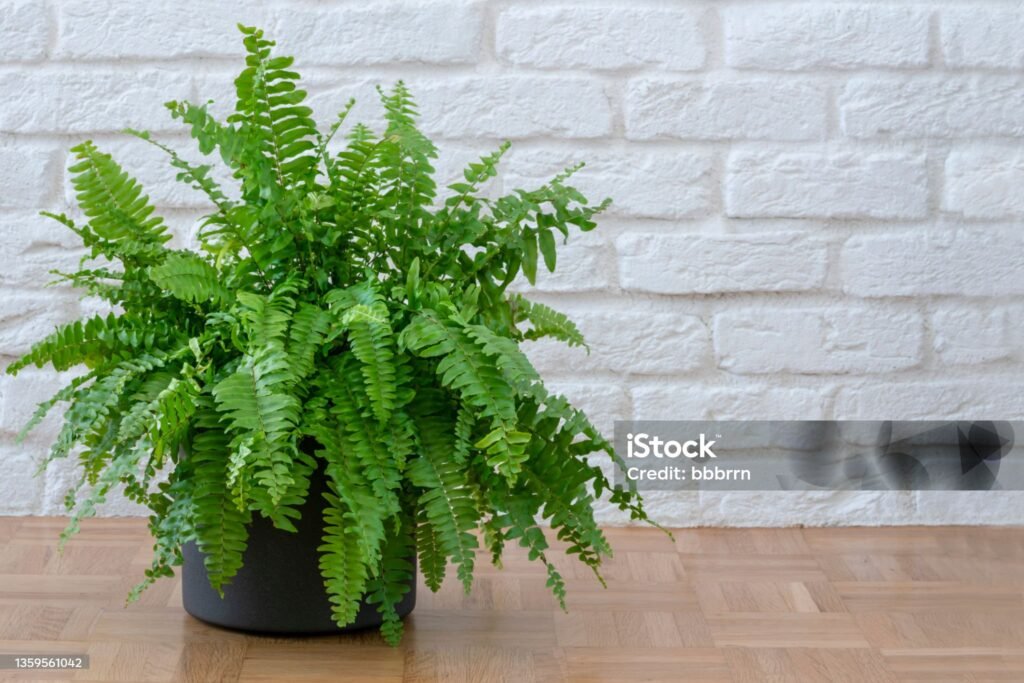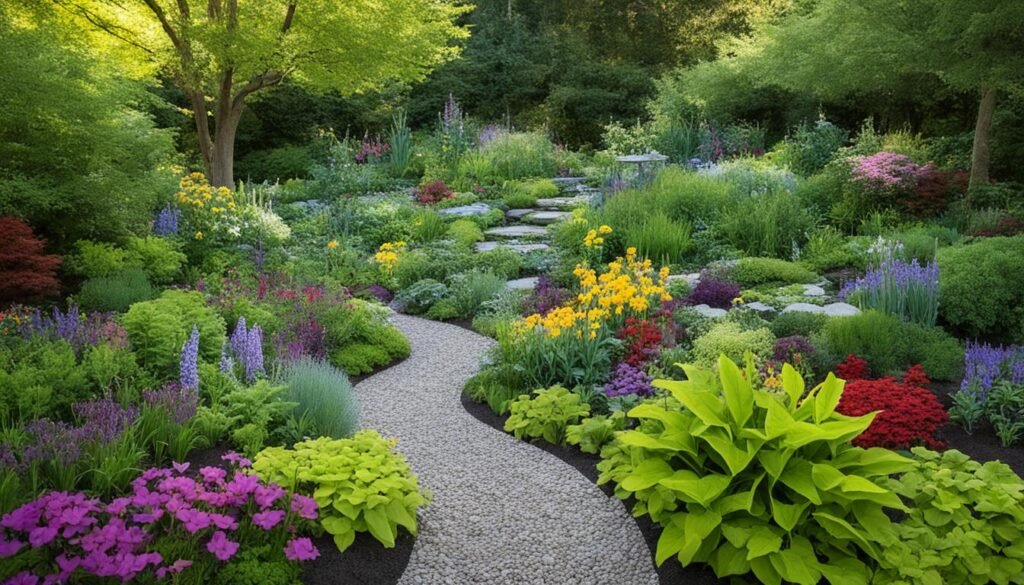Ever pondered how a simple indoor plant arrangement could turn your dining experience into a tranquil retreat?
This guide delves into the realm of indoor plant decor tailored for your dining table. The right plant selection not only boosts the room’s visual appeal but also fosters a soothing atmosphere during meals. Whether you seek the best plants for indoor arrangements or practical styling advice, we’ve covered it. Learn to enhance your dining space with lush greenery that mirrors your personal taste and harmonizes with your home’s decor. We’ll navigate through selecting low-maintenance options to creating a welcoming environment, all aimed at transforming your dining area into a vibrant sanctuary.
For additional inspiration and guidance, explore this detailed resource on decorating with indoor plants.
Understanding Indoor Plant Arrangements
Indoor plant arrangements are key to enhancing home decor. They add visual appeal and make spaces feel cozy and inviting. These displays fit well with modern, rustic, or minimalist decor styles.
Plants significantly impact mood and comfort in living areas. Studies show that greenery boosts happiness and lowers stress. Some plants also purify the air, making homes healthier. This shows how important it is to decorate with plants thoughtfully.
- Indoor plants can improve air quality by filtering out pollutants.
- They add natural beauty and color to otherwise dull spaces.
- Maintaining a diverse range of plants can create a dynamic visual impact.
- Plants help connect indoor living with the natural world outside.
As more people take up indoor gardening, learning how to arrange plants is crucial. By picking the right plants and where to put them, you can make beautiful displays. These displays can show off your style and improve health and happiness.
Choosing the Best Plants for Indoor Arrangement
Selecting the right plants for your dining table is key to creating a vibrant and attractive space. By focusing on low maintenance options and plants with unique textures, anyone can easily enhance their area. Let’s explore some excellent choices that will not only beautify your dining area but also offer valuable house plant arrangement tips for all skill levels.
Low Maintenance Options
For those with busy schedules, choosing resilient houseplants is vital. Here are some low maintenance plants that flourish with minimal care:
- Snake Plant: Known for its tolerance to neglect, the snake plant is perfect for any indoor arrangement.
- Pothos: Its trailing vines and adaptability make pothos an excellent choice for stunning displays.
- ZZ Plant: With its waxy leaves, the ZZ plant not only looks great but also requires very little water.
Plants with Unique Textures
Incorporating plants with distinct shapes and textures adds a dynamic element to indoor arrangements. Here are some to consider:
- Fiddle Leaf Fig: This plant’s large leaves create a dramatic visual impact.
- Bird of Paradise: Known for its striking foliage, it brings an exotic vibe to any arrangement.
- Rubber Plant: Its glossy leaves are sure to catch the eye and elevate any indoor display.
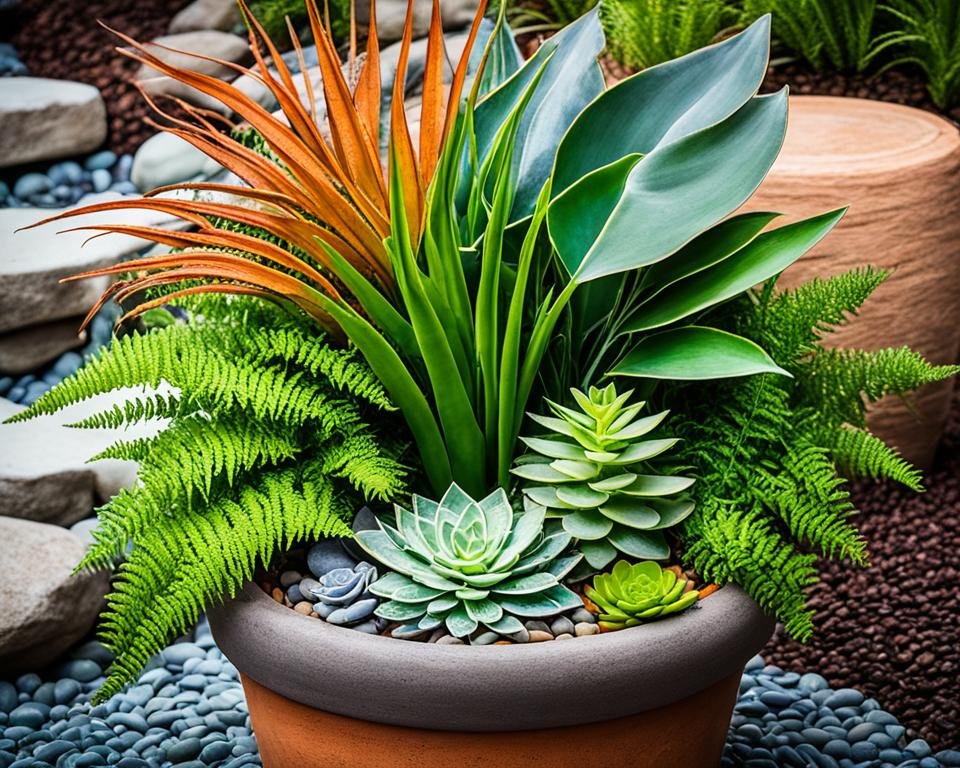
Combining these low-maintenance options and unique textured plants can lead to a beautifully diverse plant collection. When arranging, consider pairing plants with complementary characteristics for a harmonious look. This approach provides various benefits as you explore new house plant arrangement tips.
Essential Supplies for Your Indoor Plant Display
To craft a captivating indoor plant design, the selection of supplies is paramount. This segment delves into the essentials for both the aesthetic and health of your plants. It highlights the importance of containers and pots, as well as soil and fertilizers.
Containers and Pots
The visual impact of indoor plants is significantly enhanced by the right containers and pots. A variety of styles, materials, and sizes are available to suit diverse preferences.
- Ceramic Pots: Trendy and versatile, ceramic pots are excellent for both modern and rustic décor.
- Self-Watering Pots: Ideal for busy gardeners, these pots help maintain consistent moisture levels.
- Wooden Planters: Perfect for rustic indoor plant design, wooden pots add a warm touch.
- Hanging Planters: Great for saving space and adding vertical interest to your indoor plant styling.
Brands like Lechuza and Bloem offer a plethora of options for every taste. Choosing the right container not only enhances the décor but also meets the specific needs of various plant species.
Soil and Fertilizers
Proper soil and fertilizers are crucial for the health of indoor plants. Well-draining potting mixes support the diverse needs of houseplants, ensuring their roots receive essential oxygen.
| Plant Type | Recommended Soil Type | Fertilizer Type |
|---|---|---|
| Succulents | Cactus Mix | Low Nitrogen Fertilizer |
| Ferns | Peat-Based Mix | All-Purpose Fertilizer |
| Herbs | Organic Potting Soil | Herb-Specific Fertilizer |
It’s crucial to select fertilizers that cater to the specific needs of your plants. Regular repotting is often necessary as plants grow to ensure their continued health. For further guidance on selecting the right supplies, visit indoor gardening resources.
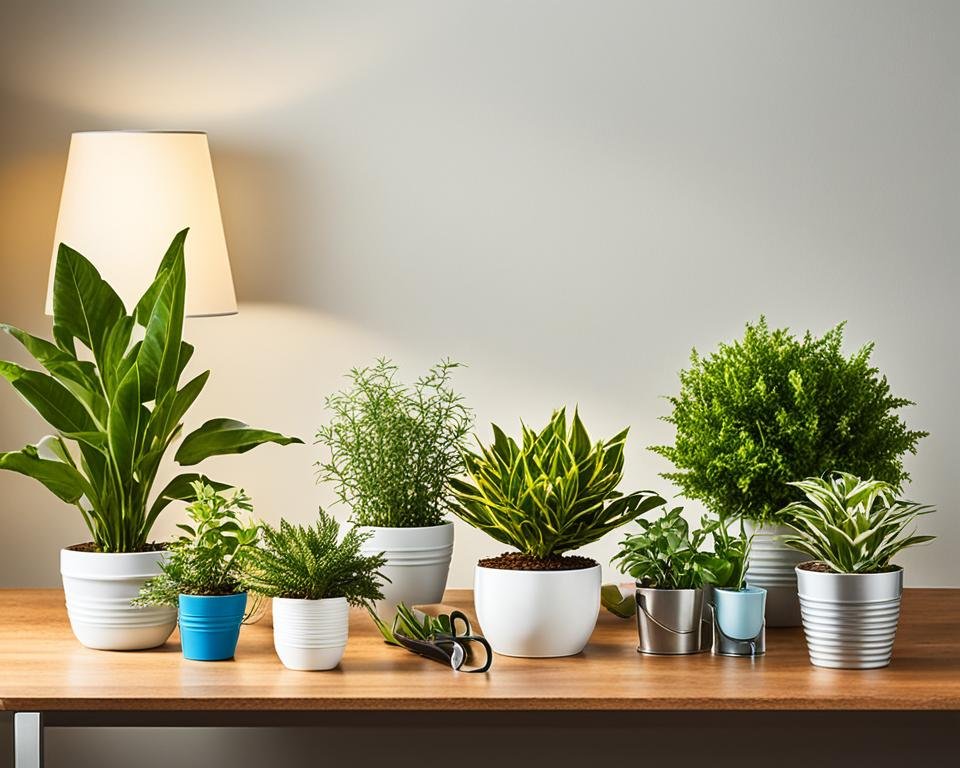
Indoor Plant Styling Techniques
Transforming your dining table into a vibrant focal point is achievable with indoor plant styling. By employing various techniques, you can enhance both the aesthetics and functionality of your arrangements. Layering heights and coordinating colors can make your indoor plant decoration ideas truly stand out, bringing warmth and liveliness to your space.
Layering Heights
Adding varied heights to your indoor plant styling creates an engaging visual experience. Consider these methods:
- Utilize plant stands to elevate certain plants, providing a tiered effect.
- Stack different pots, ensuring taller plants sit at the back and shorter ones in front.
- Mix hanging plants with table arrangements, allowing for dynamic layers.
Color Coordination
Choosing plants with complementary colors enriches your indoor plant decoration ideas. A color wheel can aid in selecting harmonizing hues. Here are some tips for effective color coordination:
| Color Combination | Suggested Plants | Visual Impact |
|---|---|---|
| Green and White | Snake Plant, Peace Lily | Fresh and Clean |
| Warm Tones | Maranta, Burgundy Rubber Plant | Cozy and Inviting |
| Cool Tones | Pothos, Blue Star Fern | Calm and Soothing |
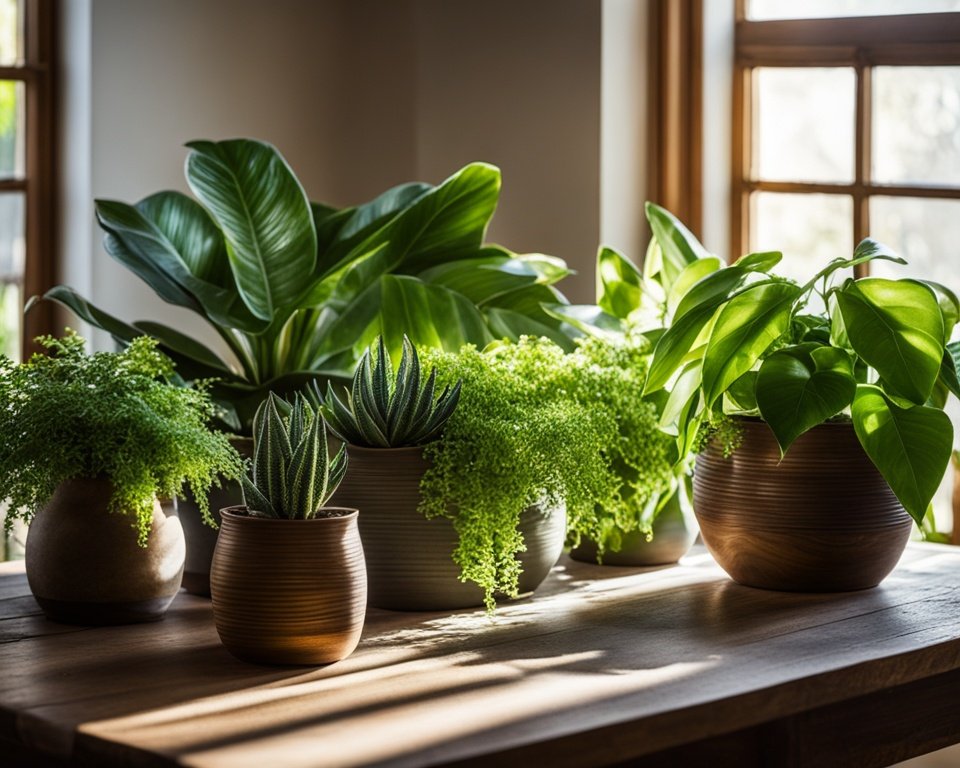
Creative Indoor Plant Arrangement Ideas
Arranging indoor plants is both a fun and aesthetic endeavor. Exploring creative indoor plant arrangement ideas not only enhances your dining table decor but also gives functionality to your space. Here are two engaging approaches that can transform your indoor plant experience.
Using Herbs for a Functional Display
Incorporating herbs into your indoor plant decor ideas offers a dual benefit. Fresh herbs like basil, rosemary, and mint provide fragrance and flavor for culinary dishes, while enhancing your table’s natural beauty. They grow well in various containers, allowing for creativity in display. Consider a tiered herb garden or individual pots for a mix of textures and heights. This setup not only serves as a captivating focal point but also encourages you to reach for fresh ingredients right at your table.
Seasonal Themes for Your Dining Table
Changing your indoor plant arrangement according to the season brings freshness and excitement to your space. For winter, incorporate evergreens or festive plants like poinsettias to evoke a holiday spirit. In spring, opt for colorful blooms like tulips or daffodils to symbolize renewal. Autumn invites rich colors with chrysanthemums or decorative gourds. These seasonal themes encourage a dynamic atmosphere, making each dining experience unique and inviting.
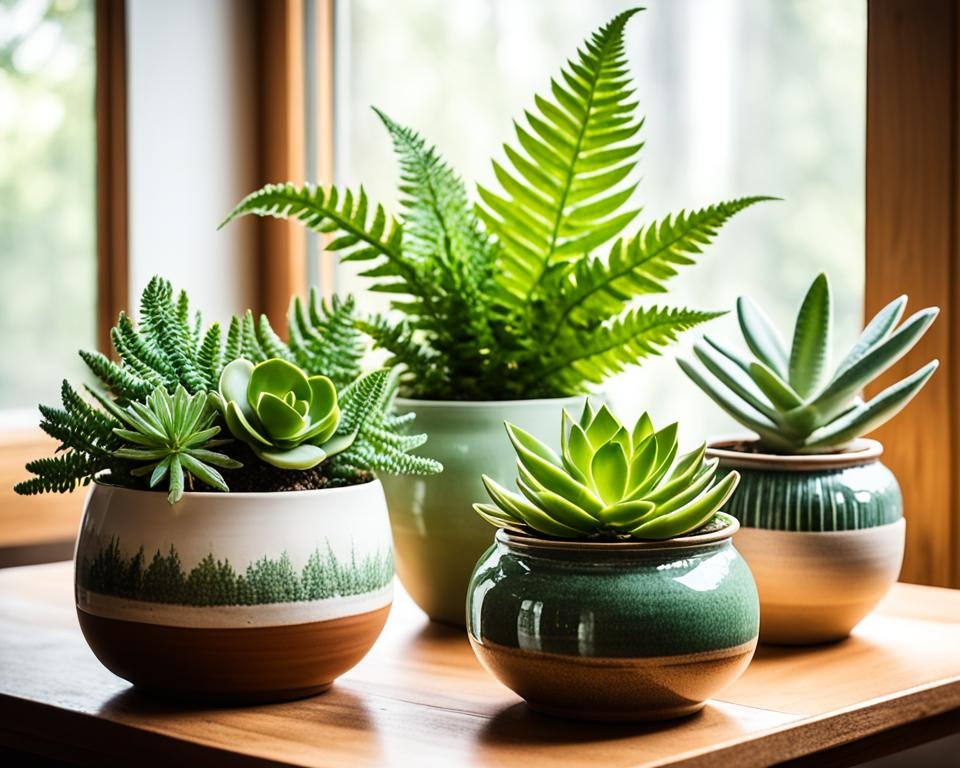
| Season | Recommended Plants | Color Palette |
|---|---|---|
| Winter | Poinsettias, Evergreens | Red, Green, White |
| Spring | Tulips, Daffodils | Pastels, Bright Colors |
| Summer | Succulents, Colorful Blooms | Vibrant Colors, Greens |
| Autumn | Chrysanthemums, Gourds | Orange, Yellow, Brown |
Indoor Plant Decoration Tips for Small Spaces
Living in a smaller space doesn’t mean you must sacrifice the beauty of indoor plants. Effective indoor plant decoration can transform your cozy quarters into a lush sanctuary. Utilizing vertical spaces opens up a world of possibilities. Wall planters or hanging pots can bring life to walls, allowing you to keep your floors clear.
When it comes to house plant arrangement tips, opt for compact species like succulents or small ferns. These plants not only thrive in limited space but also require minimal maintenance. Consider using multi-tiered shelving to create depth and dimension. Layering different plant sizes creates an intriguing visual, allowing each plant to shine.
- Choose lightweight, creative containers that can be easily repositioned.
- Use hanging baskets to add greenery while saving precious surface area.
- Consider ladder shelves to display various plants at different heights.
Incorporating a mix of textures and colors can elevate your space, making it appear larger and more inviting. Aim for an arrangement that draws the eye upward, enhancing the sense of openness in your small area. By thoughtfully selecting and arranging your plants, you can enjoy a vibrant indoor environment despite space constraints.
| Plant Type | Size | Light Requirements | Care Level |
|---|---|---|---|
| Succulent | Small | Bright, indirect light | Low |
| Pothos | Medium | Moderate light | Very low |
| Spider Plant | Medium | Indirect light | Easy |
| Fern | Small | Low to moderate light | Moderate |
Optimizing your indoor plant decoration in small spaces not only enhances the aesthetic appeal but also promotes a pleasant atmosphere that can uplift any room.
Maintaining Your Indoor Plant Arrangement
To keep your indoor plant display vibrant, regular attention is essential. Proper care boosts the arrangement’s beauty and extends its life. This guide will cover watering, pruning, and cleaning techniques vital for indoor plant upkeep.
Watering Guidelines
Watering is crucial for indoor plants. The frequency depends on the plant type but generally involves checking the soil’s moisture level. Here are some basic tips:
- Check soil moisture regularly.
- Water only when the top inch of soil is dry.
- Avoid overwatering, which can lead to root rot.
- Consider the plant’s light conditions; those in bright light may need more frequent watering.
Common mistakes include using cold water or allowing plants to sit in water. Always use room temperature water and ensure proper drainage.
Pruning and Cleaning
Regular pruning and cleaning are key to healthy growth and a stunning indoor plant display. Here are some best practices:
- Remove dead or yellowing leaves to encourage new growth.
- Trim back leggy stems to maintain shape and fullness.
- Occasionally wipe leaves to remove dust, enhancing photosynthesis.
By following these maintenance tips, your plants will stay healthy and look great, enhancing your indoor plant arrangement’s appeal.
| Plant Type | Watering Frequency | Pruning Tips |
|---|---|---|
| Succulents | Every 2-3 weeks | Remove any dead or shriveled leaves. |
| Ferns | Weekly | Trim brown fronds; promote bushiness. |
| Peace Lily | Every week | Remove spent blooms and yellow leaves. |
| Snake Plant | Every 2-3 weeks | Remove damaged leaves, shape as needed. |
Incorporating Accessories into Your Plant Display
Enhancing your indoor plant decoration can transform your space, adding charm to any dining area. By incorporating accessories, you not only add personality but also maintain your indoor plant design. Decorative stones or pebbles are an effective way to do this, offering both aesthetic and practical benefits.
Using Decorative Stones or Pebbles
Decorative stones or pebbles can significantly enhance the look of your plant arrangement. They beautify your indoor plant design and provide practical benefits. Here are some advantages of using decorative stones:
- Enhances texture and visual interest in the display
- Aids in moisture retention and drainage
- Protects the soil from evaporation, keeping plants healthier
Aside from stones, various other accessories can personalize your indoor plant decoration. Consider incorporating:
- Figurines that resonate with your personal style
- Colorful bowls that complement the plants
- Thematic decor elements, aligning with the dining space aesthetics
Integrating these accessories into your indoor plant display will create a cohesive look. It will reflect your personality while maintaining an attractive, functional arrangement.
| Accessory Type | Visual Benefit | Practical Benefit |
|---|---|---|
| Decorative Stones | Adds texture and contrast | Improves moisture retention |
| Figurines | Personalizes the display | N/A |
| Colorful Bowls | Enhances color coordination | Holds additional drainage |
| Thematic Decor | Creates a cohesive theme | N/A |
Setting Up Your Dining Table for Optimal Light
Light is vital for the health of indoor plants. It’s crucial to understand the natural light conditions in your space for successful indoor plant design. Assess the light your dining table receives throughout the day to create the best indoor plant display. South-facing windows typically provide bright sunlight, while north-facing windows may only offer indirect light. Observe how sunlight moves across your space to select the optimal arrangement.
Positioning your plants thoughtfully can enhance their growth. Consider using reflective surfaces, like mirrors or glossy table decor, to amplify light. Placing lighter-colored pots can also help reflect light onto your indoor plant display. Cluster plants with similar light requirements together, ensuring each plant has access to sufficient illumination.
For areas lacking natural light, artificial lighting solutions are beneficial. LED grow lights can create the optimal environment for plants and mimic natural sunlight. Depending on your setup, you can position these lights overhead or within the arrangement to directly illuminate your indoor plants. The right combination of natural and artificial lighting fosters a thriving indoor plant design.
Indoor Plant Design for Different Dining Table Styles
Indoor plant decor ideas can significantly enhance the aesthetic of your dining table, regardless of its style. It’s crucial to harmonize plant arrangements with your table’s design for a cohesive look that reflects your personality.
For traditional dining tables, plants with classic elegance are ideal. Ferns and peace lilies bring a timeless touch to these settings. Choose ceramic pots with intricate designs that complement the table’s woodwork. Modern tables, however, benefit from sleek lines and minimalistic decor. Opt for succulents or snake plants in geometric pots to maintain a clean, uncluttered appearance while adding vibrant greenery.
Eclectic styles offer a canvas for creative expression in indoor plant design. Combine various plants with contrasting colors and textures for a lively display. Consider hanging planters or tiered stands to maximize space and showcase your unique taste. Use colorful pots that complement the tablecloth or runner for added visual interest.
The shape of your dining table influences plant choices. Round tables are well-suited with rounded plant forms, such as dwarf citrus trees or large potted herbs. Rectangular tables can accommodate longer arrangements, such as a row of smaller plants or a single large centerpiece plant.
Below is a comprehensive table that outlines different dining table styles, suitable plants, and recommended pot types. This guide serves as inspiration for your indoor plant decor ideas.
| Table Style | Recommended Plants | Pot Types |
|---|---|---|
| Traditional | Ferns, Peace Lilies | Ceramic, Ornate Designs |
| Modern | Succulents, Snake Plants | Geometric, Metal or Glass |
| Eclectic | Diverse Mix of Plants | Colorful, Assorted Materials |
| Round | Dwarf Citrus Trees, Potted Herbs | Rounded, Natural Materials |
| Rectangular | Large Centerpiece or Smaller Rows | Longer or Taller Pots |
Conclusion
An indoor plant arrangement can significantly uplift your dining experience, infusing it with life and natural beauty. This article has delved into various indoor plant decor ideas, from picking the right plants to styling techniques that elevate your dining table’s look. Each choice not only boosts the visual appeal but also shapes the ambiance of your home.
By injecting creativity into your indoor plant arrangement, you can tailor your space to your taste while creating a welcoming atmosphere for guests and family. Practical advice on plant care, like watering and pruning, ensures your plants flourish. This makes your dining table a centerpiece of health and style.
When contemplating how to improve your indoor spaces, consider the wide array of plant display options. This is an invitation to delve into unique themes or seasonal inspirations, crafting a dynamic indoor environment that mirrors your personal style. With careful plant arrangements, your dining area can transform into a verdant oasis. This enhances your dining experience, making it more enjoyable.
FAQ
What are some popular indoor plant decor ideas for my dining table?
Popular indoor plant decor ideas for your dining table include mixing greenery with flowers. You can also use low-maintenance plants like snake plants or peace lilies as centerpieces. Seasonal elements add a touch of the current time to your decor.
How can I create a visually appealing indoor plant arrangement?
To make your indoor plant arrangement stand out, vary the plant heights and use complementary colors. Choose containers that fit your decor style. Layered and clustered arrangements can also boost the visual appeal.
What are the best plants for indoor arrangements?
Top picks for indoor arrangements include pothos, ZZ plants, fiddle leaf figs, and succulents. These plants are easy to care for and look great, making them ideal for all skill levels.
How do I maintain my indoor plant display?
Keep your indoor plants thriving by watering them regularly and ensuring they get enough light. Prune dead leaves and repot when necessary. Regularly check for pests to keep your plants healthy.
Can I use herbs in my indoor plant arrangements?
Yes! Adding herbs like basil, rosemary, or mint can beautify your indoor space and be useful in cooking. They add a pleasant aroma and practicality to your dining table.
What supplies do I need for my indoor plant decoration?
For indoor plant decoration, you’ll need containers, potting soil, and fertilizers for indoor plants. Decorative items like pebbles, stones, and stands can also enhance your arrangement.
How can I maximize plant space in a small area?
To make the most of small space, use vertical planters, shelves, and wall-mounted pots. Choose smaller plants and consider hanging plants to add depth without taking up too much space.
What lighting conditions should I consider for my indoor plants?
Assess the natural light in your space when arranging plants. Place them where they need the most light. Use reflective surfaces to boost brightness. In darker spots, grow lights can help support plant health.
How do seasonal themes influence my indoor plant design?
Seasonal themes can refresh your indoor plant design with seasonal flowers and colors. For example, using spring flowers or autumn tones can make your space feel more festive during those seasons.
Are there any specific indoor plant styling techniques to consider?
Effective styling techniques include layering plants for depth and coordinating colors for harmony. Adding decorative stones or themed decor can also personalize your arrangement.
